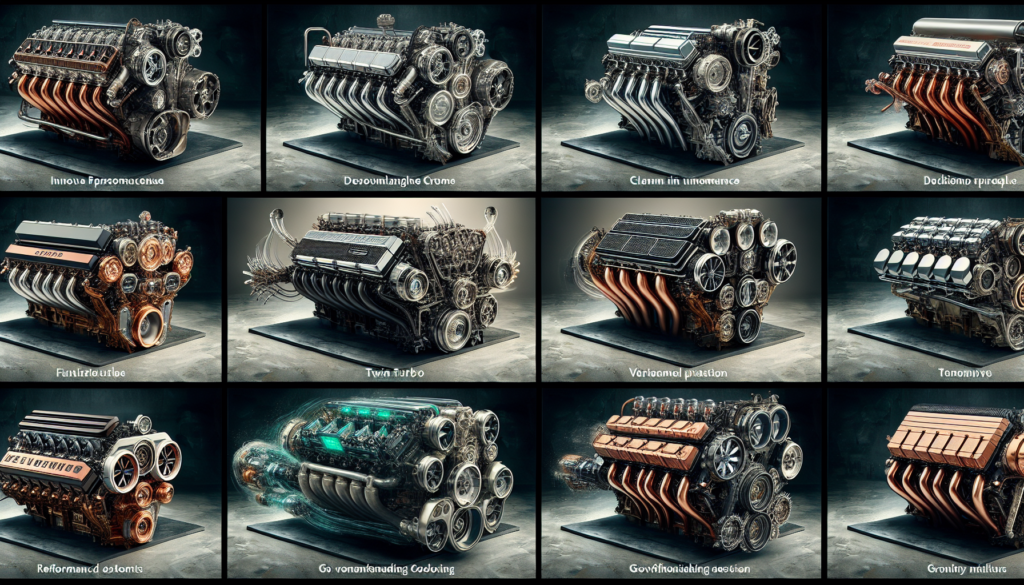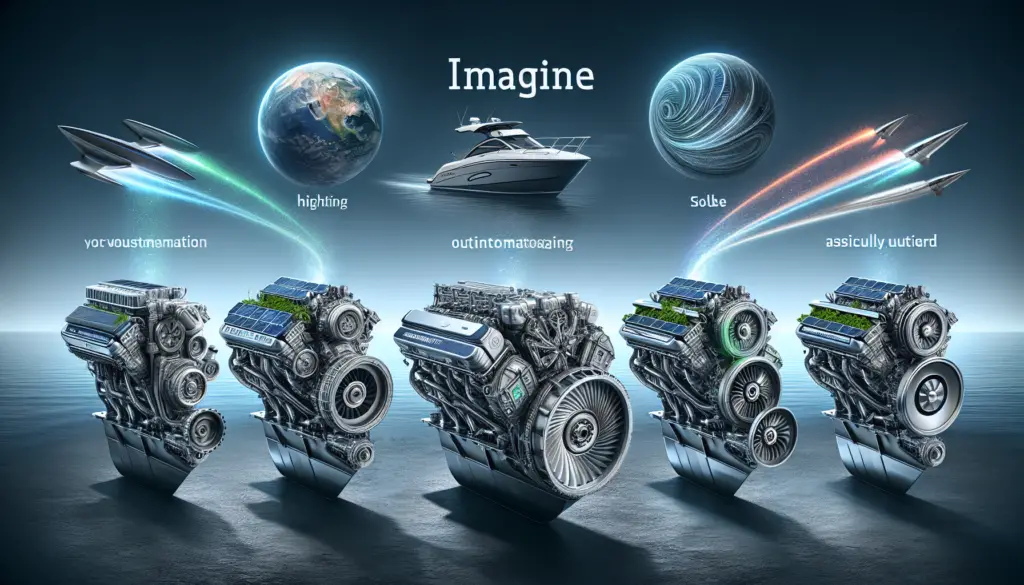If you’re looking to add a personal touch to your boat, why not start with the heart of your vessel? Your boat’s engine is not only essential for powering your adventures on the water, but it also offers numerous opportunities for customization. From upgrading the exhaust system for a throatier sound to adding eye-catching decals, there are plenty of ways to give your boat’s engine a unique flair. In this article, we’ll explore the top 10 boat engine customization ideas that will make your watercraft stand out from the crowd and make every journey an unforgettable experience.

1. Performance Upgrades
1.1 Increased Horsepower
Are you looking to give your boat some extra power on the water? One of the best ways to achieve this is by increasing its horsepower. By upgrading your boat’s engine with performance parts specifically designed to boost horsepower, you can experience a significant improvement in speed and acceleration. Whether you’re a thrill-seeker looking for an adrenaline rush or simply want to have more power at your disposal, increased horsepower is the way to go.
1.2 Enhanced Torque
In addition to increasing horsepower, enhancing torque can also greatly improve your boat’s performance. Torque is a measure of the rotational force produced by the engine, and it plays a crucial role in the acceleration and pulling power of your boat. By upgrading your boat’s engine with components that optimize torque delivery, such as high-performance camshafts or a different gear ratio, you can unleash the full potential of your boat and enjoy improved acceleration and towing capabilities.
1.3 Fuel Injection Conversion
Upgrading your boat’s carbureted engine to a fuel injection system can have several advantages. Fuel injection provides more precise control over the fuel-to-air ratio, resulting in improved fuel efficiency, better throttle response, and smoother operation. With a fuel injection conversion, your boat’s engine will perform more efficiently, allowing you to enjoy longer cruises without worrying about excessive fuel consumption.
1.4 Turbocharging
For those seeking the ultimate power boost, turbocharging is an option worth considering. By forcing more air into the engine, a turbocharger increases the power output of your boat’s engine, leading to faster acceleration and higher top speeds. Turbocharging can be particularly advantageous for larger boats that require a significant amount of power. However, it’s important to note that turbocharging may require additional modifications to the engine, such as strengthened components or improved cooling systems, to handle the increased stress.
2. Exhaust System Modifications
2.1 Upgraded Exhaust Manifold
Upgrading your boat’s exhaust manifold can have a positive impact on its performance and efficiency. The exhaust manifold is responsible for collecting exhaust gases from the engine cylinders and directing them towards the exhaust system. By replacing the stock manifold with a high-performance aftermarket option, you can improve exhaust flow, reduce backpressure, and enhance engine efficiency. This can result in increased horsepower, improved fuel economy, and a more aggressive exhaust note.
2.2 Stainless Steel Exhaust Headers
If you’re looking to further optimize your boat’s exhaust system, stainless steel exhaust headers are a great choice. These headers replace the factory exhaust manifold and are designed to improve exhaust flow by reducing restrictions and increasing scavenging. Stainless steel headers offer durability, corrosion resistance, and better heat dissipation compared to their stock counterparts. With improved exhaust flow, your boat’s engine can breathe more freely, leading to enhanced performance and responsiveness.
2.3 High-Flow Catalytic Converter
Upgrading to a high-flow catalytic converter is not only beneficial for the environment but also for your boat’s performance. While catalytic converters are primarily designed to reduce harmful emissions, they can also impose restrictions on the exhaust flow, limiting your boat’s performance potential. By installing a high-flow catalytic converter, you can maintain compliance with environmental regulations while minimizing the impact on your boat’s performance. These converters are specifically designed to provide less resistance to the exhaust flow, resulting in improved horsepower and torque.
2.4 Performance Muffler
A performance muffler is an excellent addition to your boat’s exhaust system if you’re seeking a more aggressive sound and improved performance. These mufflers are designed to minimize backpressure and increase exhaust flow, allowing your boat’s engine to breathe better. The reduced backpressure results in improved horsepower and better throttle response. Additionally, a performance muffler can provide a deeper and sportier exhaust note, enhancing the overall experience of driving your boat.

3. Intake Upgrades
3.1 Cold Air Intake
A cold air intake system is a popular upgrade for boat engines, as it provides several performance benefits. By drawing cooler air from outside the engine compartment, a cold air intake provides a denser air charge, resulting in increased horsepower and improved fuel combustion. Additionally, cold air intakes often feature high-flow air filters that allow for better airflow and filtration, further enhancing the engine’s performance. With a cold air intake, you can experience improved throttle response and better overall engine efficiency.
3.2 Throttle Body Upgrade
The throttle body controls the amount of air flowing into the engine. Upgrading to a larger throttle body can improve airflow and increase horsepower. With a larger throttle body, your boat’s engine can ingest more air, resulting in improved combustion and enhanced performance. It’s important to note that a throttle body upgrade may require recalibration of the engine’s computer system to ensure optimal performance and drivability.
3.3 Performance Air Filter
A performance air filter is an inexpensive yet effective way to improve your boat’s engine performance. By replacing the stock air filter with a high-flow performance filter, you can increase the airflow to the engine, allowing for better combustion and improved horsepower. Performance air filters are designed to provide superior filtration while minimizing restrictions in the air intake system. This upgrade is relatively easy to install and can make a noticeable difference in your boat’s performance.
3.4 Intake Manifold Enhancements
The intake manifold plays a crucial role in delivering air and fuel to the engine’s cylinders. Upgrading your boat’s intake manifold can optimize airflow and fuel distribution, resulting in improved performance. Performance intake manifolds are designed with larger runners and better airflow characteristics, allowing for increased power output. By upgrading to a high-performance intake manifold, you can take full advantage of your engine’s potential and enjoy enhanced acceleration and overall performance.
4. Ignition System Enhancements
4.1 High-Performance Spark Plugs
Spark plugs are a fundamental component of your boat’s ignition system, and upgrading to high-performance spark plugs can significantly improve engine performance. High-performance spark plugs are designed to ignite the air-fuel mixture more efficiently, resulting in better combustion, improved throttle response, and increased power output. These spark plugs often feature specialized electrode materials, such as platinum or iridium, that provide better durability and conductivity compared to standard spark plugs.
4.2 Ignition Coil Upgrade
The ignition coil is responsible for generating the high voltage required to create a spark in the spark plugs. Upgrading to a high-performance ignition coil can improve spark energy and ignition efficiency, leading to enhanced engine performance. High-performance ignition coils are designed to deliver a stronger and more consistent spark, ensuring reliable ignition under various operating conditions. With an ignition coil upgrade, you can experience improved throttle response, smoother engine operation, and potentially increased fuel efficiency.
4.3 Performance Ignition Wires
While often overlooked, ignition wires play a crucial role in delivering the spark from the ignition coil to the spark plugs. Upgrading to high-performance ignition wires can reduce electrical resistance, allowing for enhanced spark energy and more consistent ignition. These wires are typically made from high-quality materials, such as silicone or Kevlar, to provide better durability and insulation. By installing performance ignition wires, you can ensure optimum spark delivery, leading to improved engine performance and reliability.
4.4 Programmable Ignition System
For those seeking maximum control over their boat’s ignition timing, a programmable ignition system is a worthwhile investment. These systems allow you to adjust the ignition timing based on your specific needs, fine-tuning the engine for optimal performance. With a programmable ignition system, you can optimize ignition timing for different operating conditions, such as cruising or full-throttle acceleration. This level of customization can result in significant performance gains, enhanced fuel efficiency, and improved overall drivability.

5. Supercharger Installation
5.1 Roots-Type Supercharger
Installing a supercharger on your boat’s engine is a surefire way to achieve exceptional performance gains. The roots-type supercharger, in particular, is a popular choice due to its ability to deliver instant and consistent torque. This type of supercharger operates by compressing air and forcing it into the engine, creating higher cylinder pressures and significantly increasing power output. With a roots-type supercharger, you can experience exhilarating acceleration, improved top speed, and enhanced overall performance.
5.2 Twin-Screw Supercharger
Another option for supercharging your boat’s engine is the twin-screw supercharger. This type of supercharger operates by trapping air between two screw-shaped rotors and compressing it before delivering it to the engine. Twin-screw superchargers are known for their efficiency and ability to produce significant power gains across the entire RPM range. With a twin-screw supercharger, you can enjoy excellent throttle response, increased horsepower, and improved torque delivery.
5.3 Centrifugal Supercharger
Centrifugal superchargers are typically smaller and more compact than roots-type or twin-screw superchargers. They operate by using a belt-driven impeller to compress air and force it into the engine. Centrifugal superchargers are known for their efficiency at higher RPMs, making them ideal for boats that spend a significant amount of time operating at high speeds. With a centrifugal supercharger, you can achieve excellent top-end power, improved acceleration, and increased overall performance.
5.4 Installation Considerations
When considering a supercharger installation, it’s important to evaluate several factors. Firstly, ensure that your boat’s engine is capable of handling the additional stress and power generated by a supercharger. Upgraded components and modifications may be necessary to ensure the engine’s reliability and longevity. Additionally, consider the space and accessibility of your boat’s engine compartment, as superchargers require specific mounting and plumbing considerations. Finally, consult with a professional or experienced technician to ensure proper installation, tuning, and maintenance of the supercharger system.
6. Propeller Selection and Pitch Adjustment
6.1 Understanding Propeller Anatomy
The propeller is an essential component of your boat’s propulsion system, and selecting the right propeller can significantly impact its overall performance. When choosing a propeller, it’s important to consider factors such as diameter, pitch, and the number of blades. The diameter determines the size of the propeller, with larger diameters providing better low-end acceleration and power. The pitch refers to the distance that the propeller moves forward in one revolution, with higher pitches providing faster top speeds. The number of blades affects performance characteristics such as cavitation, noise, and drag.
6.2 Propeller Size and Material
Selecting the appropriate propeller size and material is crucial in maximizing your boat’s performance. Propeller size should be chosen based on your boat’s weight, engine power, and intended use. A larger propeller diameter can provide better acceleration and lifting properties, while a smaller diameter can offer higher top speeds. Additionally, the material of the propeller can affect its performance and durability. Common propeller materials include aluminum, stainless steel, and composite materials, each with its own advantages and considerations.
6.3 Pitch Adjustment for Optimal Performance
Optimizing the pitch of your boat’s propeller can have a significant impact on its overall performance. Increasing or decreasing the pitch can alter the engine’s RPM range, resulting in changes in acceleration and top speed. If your boat struggles to reach its maximum RPM range, reducing the pitch can provide better acceleration and pulling power. Conversely, increasing the pitch can help achieve higher top speeds. It’s important to note that pitch adjustments should be carefully considered and may require professional guidance to ensure optimal performance and avoid damaging the engine.
6.4 Tips for Propeller Maintenance
Proper propeller maintenance is essential for maintaining optimum performance and preventing damage. Regularly inspect your propeller for any signs of damage, such as dents, cracks, or bent blades. Additionally, ensure that the propeller hub is properly greased to prevent corrosion and allow for smooth operation. If you notice any significant damage or performance issues, consider having your propeller professionally serviced or replaced. Lastly, always follow the manufacturer’s guidelines for propeller maintenance and consult with a professional if you have any concerns about the condition or performance of your propeller.

7. Electronic Fuel Injection System
7.1 Benefits of EFI Conversion
Converting your boat’s carbureted engine to an electronic fuel injection (EFI) system can provide numerous benefits. EFI systems offer precise control over the fuel-to-air ratio, resulting in improved fuel efficiency, better throttle response, and smoother engine operation. With EFI, you can expect quicker starts, reduced fuel consumption, and decreased emissions. Additionally, modern EFI systems often incorporate advanced features, such as self-diagnostic capabilities, closed-loop operation, and improved cold-start performance.
7.2 Installation and Calibration
Installing an EFI system requires careful consideration and planning. It typically involves retrofitting your boat’s engine with new components, such as fuel injectors, an electronic control unit (ECU), and a high-pressure fuel pump. Additionally, sensors, such as the manifold absolute pressure (MAP) sensor and the throttle position sensor (TPS), are necessary for proper EFI operation. Once installed, the EFI system needs to be calibrated to ensure optimal performance and drivability. This involves adjusting fuel maps, ignition timing, and other parameters to match the specific characteristics of your boat’s engine.
7.3 Adjusting Fuel Maps
Fuel maps determine the amount of fuel injected into the engine based on various operating conditions, such as engine load and RPM. Adjusting the fuel maps allows you to fine-tune the EFI system’s performance and optimize fuel delivery for different situations. This can include adjusting the air-to-fuel ratio, determining fuel injector pulse widths, and modifying ignition timing curves. Proper fuel map adjustments can result in improved power, better throttle response, increased fuel efficiency, and reduced emissions.
7.4 Monitoring and Troubleshooting
One of the advantages of an EFI system is its ability to provide real-time data and diagnostics. Monitoring systems allow you to keep track of important parameters, such as engine temperature, fuel pressure, and oxygen sensor readings. This information can help you identify potential issues, such as fuel system malfunctions or sensor failures, and take appropriate action. Additionally, most EFI systems feature self-diagnostic capabilities, which can assist in troubleshooting and identifying problems quickly and accurately.
8. Cooling System Upgrades
8.1 Improved Water Pump
The water pump plays a critical role in maintaining the optimum operating temperature of your boat’s engine. Upgrading to an improved water pump can enhance your boat’s cooling system and overall engine performance. High-performance water pumps are designed to provide better coolant flow rates and improved cooling efficiency. By circulating coolant more effectively, these pumps can help prevent overheating, reduce the risk of engine damage, and maintain consistent performance even in demanding conditions.
8.2 High-Performance Radiator
A high-performance radiator is another essential component for maintaining engine temperature and preventing overheating. High-performance radiators are typically designed with larger core sizes and improved cooling fins, allowing for better heat dissipation. Additionally, these radiators often incorporate better materials and construction techniques to ensure durability and efficient heat transfer. Upgrading to a high-performance radiator can provide better cooling capacity, reduced risk of overheating, and improved overall engine performance.
8.3 Upgraded Intercooler
If your boat is equipped with a forced induction system, such as a supercharger or turbocharger, upgrading to an improved intercooler can significantly enhance performance. Intercoolers are designed to cool the compressed air before it enters the engine, maximizing the air density and consequently increasing power output. High-performance intercoolers feature larger surface areas, better airflow characteristics, and improved heat transfer capabilities. By upgrading to an upgraded intercooler, you can reduce the risk of heat-induced power loss and achieve better overall engine performance.
8.4 Thermostat Modifications
Modifying your boat’s thermostat can provide additional control over the cooling system and optimize engine temperature. A lower temperature thermostat allows coolant to circulate earlier, reducing the risk of overheating and maintaining a consistent operating temperature. This can be particularly beneficial in high-performance applications where increased heat levels are a concern. However, it’s important to ensure that the modified thermostat is compatible with your boat’s engine and cooling system and does not compromise its overall performance and reliability.

9. Engine Tuning and Remapping
9.1 Understanding Engine Management Systems
Modern boat engines are equipped with sophisticated engine management systems that control various aspects of engine performance, including fuel delivery, ignition timing, and sensor feedback. Understanding how these systems operate and interact with your boat’s engine is crucial for effective tuning and remapping. Engine management systems utilize various sensors, such as the oxygen sensor and mass airflow sensor, to monitor engine conditions and adjust parameters accordingly. By manipulating these parameters, you can fine-tune your boat’s engine for optimal performance, power delivery, and fuel efficiency.
9.2 Custom ECU Remapping
Remapping the engine control unit (ECU) is one of the most effective methods of tuning your boat’s engine. ECU remapping involves modifying the software that controls the engine’s performance parameters, such as fuel maps and ignition timing curves. With custom ECU remapping, you can optimize these parameters to suit your specific needs and preferences. This can result in improved power delivery, enhanced throttle response, increased fuel efficiency, and overall better engine performance. It’s important to note that ECU remapping should be performed by a professional tuner with experience in marine applications to ensure proper calibration and avoid potential engine damage.
9.3 Dyno Tuning
Dyno tuning is a valuable tool in the engine tuning process, allowing for precise measurements and adjustments. Dyno tuning involves running the engine on a dynamometer, which provides real-time data on various engine parameters, such as horsepower, torque, air-fuel ratio, and exhaust gas temperature. By analyzing this data, a professional tuner can make precise adjustments to the engine’s performance parameters, ensuring optimum performance and drivability. Dyno tuning is especially beneficial for high-performance applications, as it allows for fine-tuning under controlled conditions.
9.4 Benefits of Engine Tuning
Engine tuning offers numerous benefits for boat owners seeking to maximize their engine’s performance. By optimizing fuel delivery, ignition timing, and other parameters, engine tuning can result in increased horsepower, improved throttle response, and enhanced overall performance. Additionally, engine tuning can improve fuel efficiency, allowing you to cruise for longer distances without frequent refueling. Engine tuning is a versatile customization option that can be tailored to your specific needs and preferences, from mild improvements to full-blown high-performance upgrades.
10. Nitrous Oxide System Installation
10.1 Understanding Nitrous Oxide
Nitrous oxide (N2O), commonly known as “nitrous,” is a chemical compound that can be used to provide a significant power boost to your boat’s engine. Nitrous oxide is stored as a liquid in a pressurized bottle and injected into the engine as a gas. The additional oxygen provided by the nitrous oxide allows for more complete fuel combustion, resulting in increased horsepower and torque. Nitrous oxide systems can provide substantial power gains when used responsibly and in conjunction with other engine modifications.
10.2 Wet and Dry Systems
Nitrous oxide systems are typically categorized as either wet or dry systems. Wet systems incorporate both nitrous oxide and additional fuel, ensuring the proper air-fuel ratio is maintained. Dry systems, on the other hand, only introduce nitrous oxide into the engine, relying on the existing fuel injectors to provide the necessary fuel. Both wet and dry systems have their advantages and considerations, and the choice between the two depends on factors such as engine setup, desired power gains, and maintenance requirements.
10.3 Proper Installation and Safety Considerations
Proper installation and safety precautions are critical when it comes to nitrous oxide system installation. Nitrous oxide is a highly reactive gas, and any mishaps or incorrect installations can result in catastrophic engine damage or even personal injury. It’s essential to have a professional technician install the system according to the manufacturer’s guidelines and recommendations. Additionally, always ensure that the nitrous oxide bottle is secured properly, the lines and fittings are in good condition, and all safety devices, such as pressure relief valves and blow-off valves, are functioning correctly.
10.4 Power Boost and Performance Gains
Nitrous oxide systems offer a significant power boost and impressive performance gains when used responsibly and in conjunction with other engine modifications. Depending on the specific system and engine setup, power gains of up to 200 horsepower or more can be achieved. The power boost provided by nitrous oxide can result in quicker acceleration, higher top speeds, and overall enhanced performance. However, it’s important to emphasize that proper tuning and engine modifications should accompany nitrous oxide system installation to ensure optimum performance and reliability.

